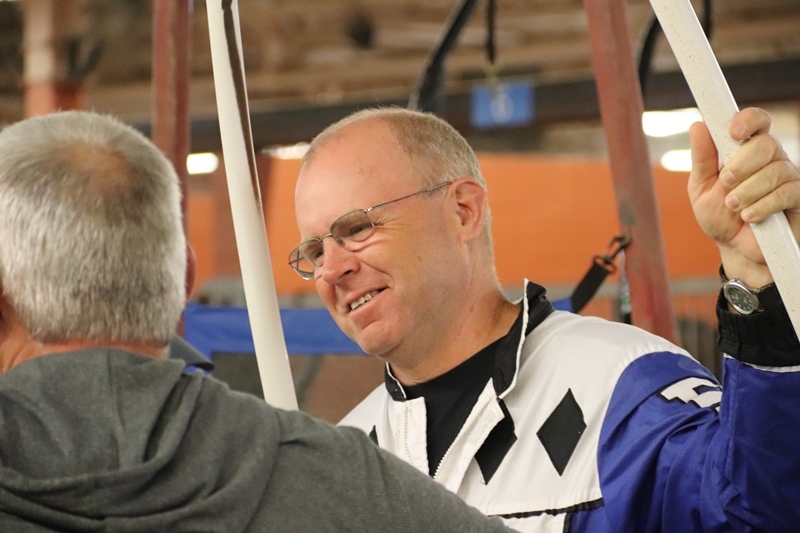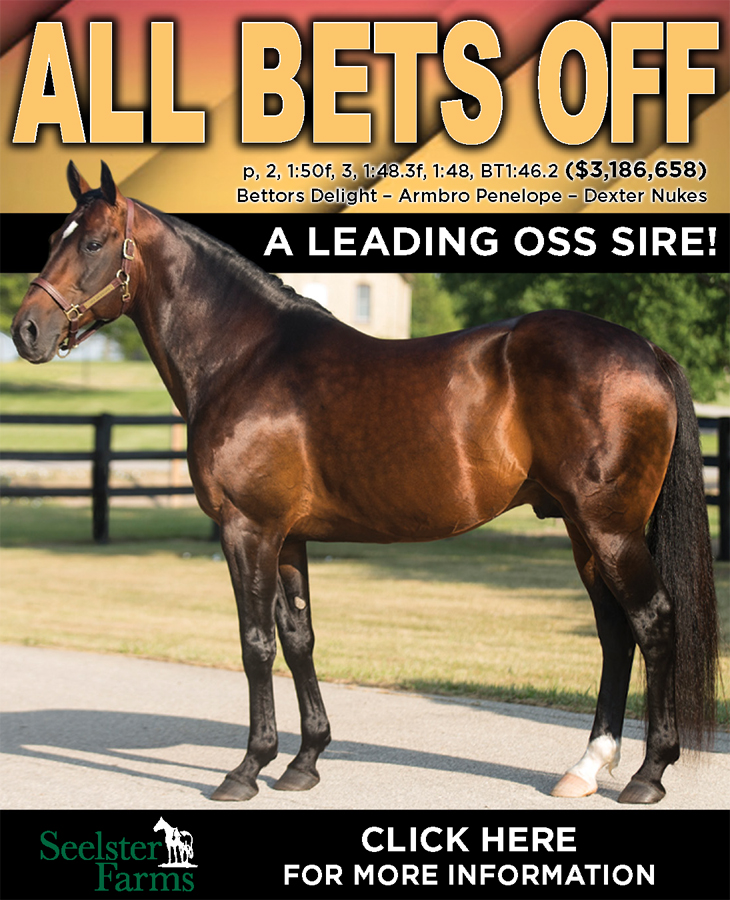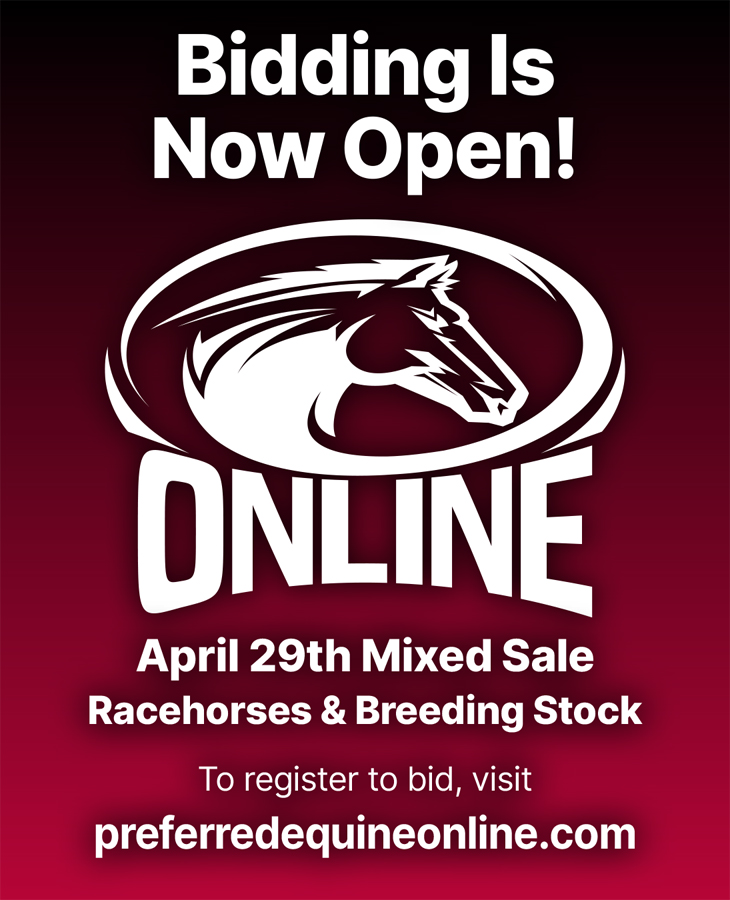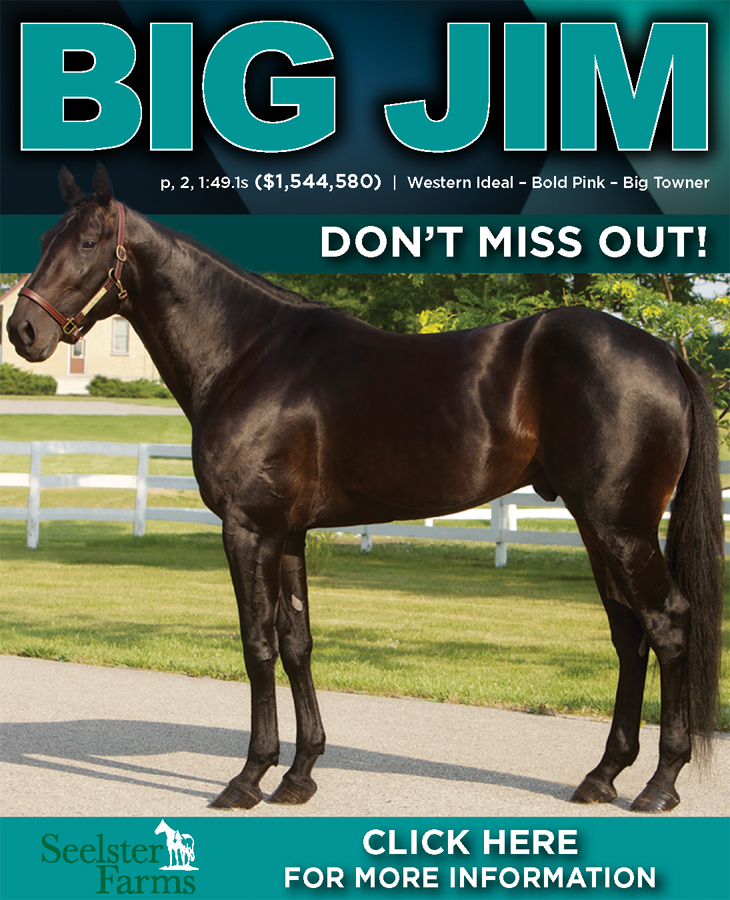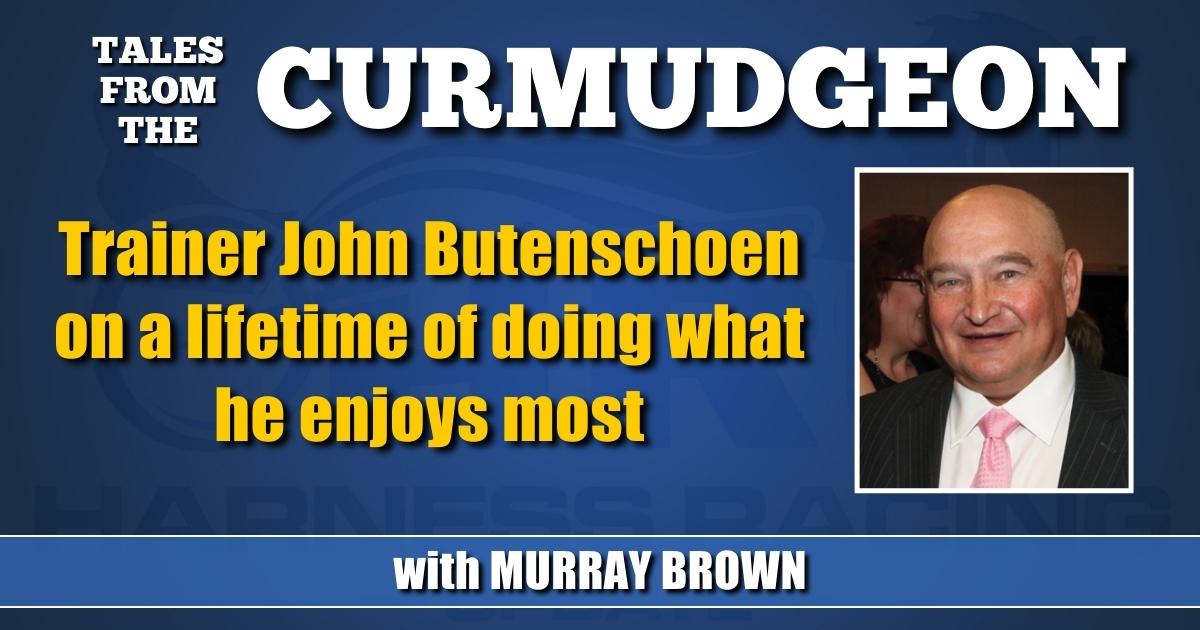

Trainer John Butenschoen on a lifetime of doing what he enjoys most
The Midwesterner on working for Delvin Miller and his close relationships with Erv Miller and the late Brian Pinske.
by Murray Brown
When I asked John Butenschoen if he was born into the sport that has been his means of making a living, his answer was, “Well, sort of.”
His roots are midwestern, Illinois to be specific. His dad, Walter, farmed corn, soybeans and wheat and then sort of migrated to harness racing.
Walter had a friend, Dave Samuelson, who owned a bar in their home town Marengo, where the two friends would occasionally get together. En route to the bar they might stop at Maywood Park, where they would enjoy the racing.
John speculates that perhaps one evening the friends might have had one beer too many. They decided to claim a harness horse with which they could have some fun racing at Maywood.
It was 1975 and young John Butenschoen was all of 12 years old. That one claimer led to several, all of the cheaper variety. John became quite interested in his dad’s horses and began to help in taking care of them.
They were trained by Bob Welch, Roger’s dad. John and Roger were about the same age and became friends.
John’s dad began boarding a few horses, mostly turnouts at the farm. Eventually a training facility and a track were added.
In 1982, John received a call from his friend Roger Welch who was at Pompano Park working for Jack Ackerman. “We are stabled next to Delvin Miller. They need some help. Are you interested?” “Am I interested? Of course, I am.” What aspiring young horseman wouldn’t be interested in going to work for the man that many then considered to be among the greatest of all horsemen ever. He quickly packed his car and was on his way to Florida.
When he arrived he was given two head to take care of under the direct supervision of Delvin’s right hand man, Aime Choquette.
“Aime was a great, great horseman,” John said. “What he didn’t know about horses probably wasn’t worth knowing. He had tremendous patience both with horses and with people.”
John Butenschoen spent four years with the Miller Stable. He wintered during the golden years of Pompano Park. Most of the great Grand Circuit stables were headquartered there.
“Those years I spent at Pompano were fantastic. I’d love to have the opportunity to relive them. I was having a great time, but maybe I was too young to really appreciate what we had. You know the old saying, ‘Youth is wasted on the young.’ That wasn’t completely so for me, but the business was at its height. The Meadowlands had just opened. I was living life to its fullest.”
Delvin gave the young man what John felt was the opportunity of a lifetime. He allowed him to take two head on the road and race them on the Pennsylvania Fair Circuit.
“Delvin asked me to enter, train them, take care of them and ship them to their next race. All I had to do was keep in touch with him and let him know how they raced.”
There was a huge added benefit with being able to work for Delvin Miller. John met Jackie Kiger the woman who was to become his wife. Jackie’s dad, Jack, was the manager of the Miller Brothers (Delvin and Albert) Bancroft Farm and its adjoining Meadowcroft Village in Avella, PA. Jackie grew up on farm. John had been sent to Bancroft to help with the worming of some mares and their foals. It was there that he met Jackie.
“She has been a godsend to me, not only by being a great wife to me and mother to Tyler, but also in being a big part of running the entire business end of the operation. I train and pick the horses. Jackie does just about everything else. The stable would be lost without her.”
John worked with Delvin and Aime for four years before deciding to return to Illinois with his new bride and set up his own stable.
There he remained, racing horses, mostly Illinois breds on the Illinois circuit for the next 23 years.
While there, he retained his friendship with Roger Welch and made numerous lifelong friendships including a young Minnesotan name Brian Pinske whom he met while at The Meadows. Pinske and his grandfather Bob were there racing a few horses.
In addition to the Illinois breds, John would train a few youngsters eligible to stakes in New York, New Jersey and Pennsylvania. When these out of staters were ready to race, he would ship them to stables in the respective states to which they were eligible.
When things began to go bad for racing in Illinois, John saw the writing on the wall and decided to move his operation to the east, when he saw the tide turning.
He has now been headquartered at Wind Gap Farm in close proximity to Pocono Downs during the racing season and spends his winters at the Pinske-owned training center Southern Oaks in Central Florida.
It was at Southern Oaks where this scribe caught up with him.
Q: What can you tell me about your career in harness racing?
“As is the case with a lot of the folks involved in the sport, I’ve been lucky to make a living doing something that I thoroughly enjoy. I’ve been fortunate enough to be moderately successful. I’ve had wonderful group of owners who have stuck with me through the good horses and the ones that maybe weren’t good enough.”
Q: Tell us about the makeup of your stable today.
“If I were to use one word to describe it, that word would be diverse. We have a total of 43 horses in training. We left three racehorses up north with our son Tyler. It has been somewhat of a chore getting them raced because of the uncertainties of the weather up there. We have 40 down here in Florida of which 26 are 2-year-olds. They are eligible to race in a bunch of jurisdictions — Pennsylvania, New York, New Jersey, Ontario, Indiana and Kentucky. Ironically, we do not have a single yearling from my home state of Illinois. Dual eligibility, especially including Kentucky, has been a great boost. With the new track opening there, we will now be able to race there for good money from Spring through late Fall. Dual and in some cases even triple eligibility has become a significant factor to yearling buyers. Those breeders that have them have and will benefit, those that do not will likely be negatively impacted.”
Q: If this scribe were to pick the 10 trainers who spend the most time in doing their homework in looking at yearlings and being prepared for every major sale and even some of the minor ones, you would certainly be included.
“I’m kind of lucky in that I don’t consider that part of the job to be at all onerous. I actually love looking at horses. It’s not work to me, it’s enjoyment. There is very little that I enjoy more than going to the various farms and looking at the yearlings in their home environment and then, if at all, possible seeing the ones that I have enough time for being turned out in the paddock. I also enjoy the banter with the farm managers and other horsemen that I encounter on my visits.”
Q: You used the word “I.” However, from my experience, when you visit a farm to look at yearlings, you are almost always accompanied by your friend Erv Miller. You are somewhat of a consignor’s dream. You generally look at the same ones at the same time, thus making things easy for the farms, the help and of course the horses.
“Erv and I have been friends for a long time. We have so many things in common. We are both about the same age. We both have sons the same age in the business. Our wives are friends. We both train at Wind Gap in the Summer and at Southern Oaks in Winter. We met indirectly through Delvin Miller. Delvin had a one-eyed gelding named Tarport Ramey that he said would set the world record for a 2-year-old trotting gelding. He did, winning in 1.58. Delvin sold him to one of Erv’s owners. Tarport Ramey was at Hawthorne scheduled to race in the Dygert there. I went to visit him. I met Erv. We’ve been friends ever since.”
Q: One of your good friends was Brian Pinske who accomplished a whole lot in the terribly short period of time allotted to him. His loss at such a young age was a great loss not only to all that knew him, but also to the entire industry.
“Brian was a special guy. I first met him when we were both racing at Quad City Downs. He had an abundance of energy and made friends with just about everybody that knew him. He was an exceptional horseman as well. His unexpected death was just a horrible loss to us all. That was one of the most terrible days I’ve ever experienced. His parents had lost another son in a car accident several years before. I’ll never forget his dad Tim’s tearful words to me, ‘I’ve only got one left.’ It was beyond horrible. He hadn’t yet told his remaining son Karl and couldn’t imagine how he was going to do it. To a limited degree I knew how he felt. Jackie and I had lost an infant son. Nothing could be worse for a parent. It happened while the Harrisburg sale was taking place. Brian had bought several yearlings. We didn’t know for whose account they were. Several of us got together and together with Brian’s parents Tim and Marlys and before the sale was over we had found owners for all of them.”
Q: You began training in South Florida when working for Delvin. You are now in central Florida, where you prefer to train and live. Why?
“Probably first and foremost is the Southern Oaks Training Center owned and managed by the Pinske family. If there is a place that I’d describe as Horse Heaven this might be it. As you know, it was originally built and designed by Mr. Simpson. His son, Jim, supervised its building according to Mr. Simpson’s instructions. As I understand it, he wanted the racetrack to be modeled after Springfield which he considered to be the best track in existence. He wanted paddocks — lots of roomy paddocks where horses could be turned out. As great a job as Jim did in building it, the Pinske family have taken it a step or two beyond. We now have three tracks on which the horses can be trained. Everything that can be done to make it a great experience for both horses and people is there. The only possible negative is that once we leave here, the experience for both people and horses can only go in one direction.”
Q: In the racing season you train at Wind Gap which is fairly close to Pocono Downs.
“We’ve been there for quite a while now. We have a home on five acres. There’s an interesting story that goes with the place. I was in Canada racing. I called home to check on how things were there. Jackie told me, ‘I bought a house.’ ‘You did what?’ I said. ‘I bought a house.’ ‘What if I don’t like it?’ I responded. ‘It doesn’t matter. We are moving there anyway.’”
Q: Do you do anything different now than when you were starting out?
“Most definitely. I expect that 10 years from now I still will be doing things differently. The breed has changed and keeps changing. In addition to changing with it, we have to realize that what is good for some horses may not be beneficial to others. Generally speaking, I try to do what has worked for me in the past. However, if that doesn’t work, I am always open to change. If there is one overriding philosophy it has to be to try to keep our horses fit and happy. There are times when we are too hard on them. It’s not easy being a racehorse. When we are too hard on them, such as racing them too hard or too often, they under perform. That is usually not their fault. It is ours. We need to try to look into them and empathize with their needs. If we do that successfully, they will perform accordingly.”
Q: Do you have a philosophy when shopping for yearlings?
“That can probably be summed up in one word — value. I would describe myself as being a middle of the road or maybe even a slightly below middle of the road shopper. That doesn’t mean that I won’t look at as many of the higher-priced yearlings as I can find. Chances are that I will look at close to all of them. There are several reasons why. The first is that I really enjoy looking at horses. I don’t consider it to be hard work. The second is that there is an advantage to being prepared. You never know when one that you expect to bring big bucks, just doesn’t. Sometimes there may be a good reason for that happening. Occasionally there won’t be.
“I’ve found that in looking at yearlings by the ‘flavor of the day’ stallions — those are at the top of the heap — there is a tendency for those to bring higher prices than I might think they are worth. On the other hand, I find there is often to be great value to be found in those stallions who I know to be capable of siring good horses, but for whatever reason are out of favor. An example in recent years might be a horse like Cantab Hall who is a proven great stallion, but whose yearlings sometimes now get overlooked in the sales ring. I’d much sooner have a Cantab Hall that I consider to be at or near the best of his breed than a Muscle Hill or Walner that might be in the lower segment of those being offered. Other sometimes overlooked stallions I’ve had good luck with are Life Sign, Explosive Matter, Western Terror and Yankee Glide.”
Q: Pacers or trotters. Which do you prefer?
“Trotters of course. That’s obvious with me. We have 26 2-year-olds and 20 of them are trotters. I would say though that last year’s sales were somewhat of an anomaly. The pacing market, especially for fillies, was red hot. Although trotters were strong, they were not on a relative basis as strong as pacers, especially in the price range where I do most of my shopping.”
Q: How much credit do you give to seeing one turned out in a paddock?
“A whole lot. It certainly gives you some insight to their athleticism and attitude. You have to be a little careful there, as well. Some horses do have bad days. That’s where the farm manager and your trust in him or her come into play. This might be the fifth time that the particular yearling has been turned out and it is just tired or has had enough for the day. If I ask for one to be paddocked, there is a good chance that I already like it. In most cases, it would have to show me something that I don’t want to see in order to get it crossed off my list.”
Q: What’s the best horse you’ve ever had in your stable?
“Without a doubt, that would be Plesac. He might not have been the greatest trotter ever, but he was darned good. If I were going to use one word to describe him, that would be consistency. He never went a bad race. He didn’t win them all, but he was usually right there and rarely didn’t get a check. We bought him as a yearling for $24,000 and he earned $2,501,758.”
Q: Do you have a special type of yearling, a prototype?
“Yes and no. I’ve had big and small horses in my stable. Short and tall. But most of the yearlings I buy have a certain look about them. If you asked me to describe it, I couldn’t. But just about all have that ‘it’ factor — whatever ‘it’ might be.”
Q: Who are the greatest horsemen you’ve known?
“Of course, I’d have to start with Delvin and Aime. Then there have been others, lots of others. In order to survive in this business, you’ve got to be good. It would be a long list, some well-known, others not quite as well thought of. Some names that would have to be included would be Jim Dennis, Brian Pinske, Ray and Larry Remmen and Erv. Then of course there are the obvious ones — guys like Ronnie Burke and Jimmy Takter. One guy who I don’t believe gets the credit he deserves is Danny Altmeyer. He is not only an excellent horseman, he is perhaps even more importantly an exceptional human being.”
Q: Do you have any favorite breeders that you like to buy from?
“Not really. If I believe the breeder raises a good horse I will look at their yearlings. I’d be remiss if I didn’t mention Doc and Pat Walker, though. They gave me my start in the yearling game. I’ll be eternally grateful to them. There are a few, very few who I won’t patronize, mostly because of the way I’ve felt I’ve been treated or maybe mistreated. The buyer holds all the cards in this game. He alone decides who to buy from, which ones to bid on and how high to go. Most breeders realize this and treat their prospective patrons accordingly.”
Q: How would you liked to be remembered?
“Probably as just a good old farm boy, who was lucky enough to spend his life doing what he most enjoyed.”
Have a question or comment for
The Curmudgeon? Reach him by email at: hofmurray@aol.com









